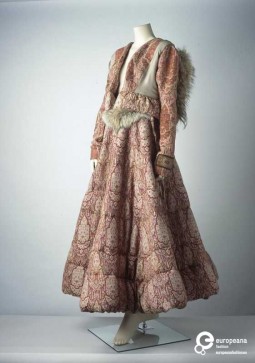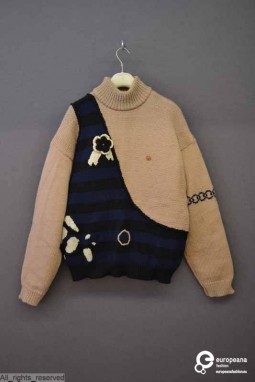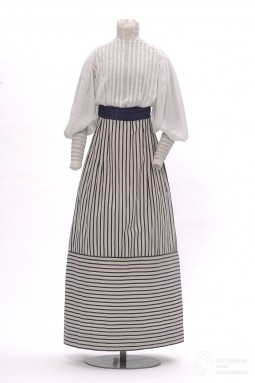Posts Tagged ‘newsletter’
Europeana Fashion Focus: Ensemble by Yohji Yamamoto, A/W 2000/2001

The outfit is composed by a hooded jacket and a long skirt. Both pieces are in cashmere wool, and present different patterns, recalling traditional Indian designs; the finishings are in coyote fur. It was part of autumn/winter 2000/2001 collection by japanese fashion designer Yohji Yamamoto.
The jacket is short and fitted, with no collar, and closes on the front with a safety-pin. The sleeves are made of a single layer of fabric, and on the left sleeve is a label with an Indian motif. For the jacket two materials have been used: a wool fabric with woven cashmere motifs in salmon, gray, green and red, and a silk twill in plain beige-gray. A silk and cashmere hood, lined with coyote fur, is attached to the jacket with four buttons. The full, A-line skirt is made from the same cashmere fabric of the jacket, and lined inside with silk twill. Between the two layers of fabric there is an inner layer, made of polyester, which makes the skirt flared. The waist is also trimmed with coyote fur.
The outfit was designed by Yohji Yamamoto, as part of his A/W 2000/2001 collection. The japanese designer joined together suggestions from different populations, reflecting on their clothing habits, linked to traditional techniques and materials; from India to Mongolia and North America, the influences draw trajectories and reflect on how people in different countries and contexts respond to the environment, keeping up with nature and its variations. The collection fits coherently in the creative view of the designer, who favours oversized volumes, thick fabrics and unexpected materials; it also seems to show how clothes can protect and, at the same time, be a symbol, declaring the identity of the wearer through patterns and cuts; these elements together recall peculiar traditions and customs of a precise place, and associate people, in their instinctive behaviours, across the world.
The object is part of Centraal Museum Archive. Discover more on the Europeana fashion portal.
Europeana Fashion Focus: Sweater by Walter Van Beirendonck, 1987


Sweater by Walter Van Beirendonck, A/W 1987-88. Courtesy MoMu - Fashion Museum Antwerp, all rights reserved.
This sweater in knitted wool was designed by Belgian fashion designer Walter Van Beirendonck for his ‘Dare Devil Daddy’ A/W 1987-88 collection. Its trompe l’oeil design reminds of the typical look of the ‘strongest man on earth’ character from twentieth century freak shows.
The sweater is oversized and presents an asymmetric pattern. On the left, a one-strap tank top in black and blue stripes, with a belt and a crocheted white flower appointed on the top, is reproduced. The right side and the sleeves are in pinkish wool, recalling bare arms and a naked chest, showing a nipple crocheted in wool. The right arm is decorated with a ‘knitted’ tattoo.
Walter Van Beirendonck graduated from the Fashion Department of the Royal Arts Academy in Antwerp in 1980, and he has presented his own collections since 1983. He is now the director of the department, leading students of one of the most prestigious institution for fashion-designers-to-be. He is, along with Marina Yee, Dirk Van Saene, Dirk Bikkembergs, Ann Demeulemeester and Dries Van Noten, one of the ‘Antwerp Six’: a group of fashion designers formed in Antwerp who made great sensation in the international fashion scene between the 1980s and 1990s, imposing their innovative views to the system.
Van Beirendonck’s collections, whose names are usually characterized by playful alliterations, such as ‘Dare Devil Daddy’ take their inspiration from art and literature, and point out the designer’s outstanding view on fashion. This collection laughs at the ultimate fitness craze, presenting ‘cuddly’ kind of men wearing comfortable oversized clothes with extra padding. These lovely ‘daddies’, with their sweaters embroidered with words like ‘Hug Me’ or decorated with crocheted flowers, dared to sport pieces inspired by circus and freak shows’ artists and clowns. A second part of the collection, called ‘Rabbit Virility’ instead, seemed to be directed to the ‘Macho-Bunnies’ with rabbit ears and puffy tails.
The object is part of MoMu – Fashion Museum Antwerp Archive. Discover more on the Europeana fashion portal.
Europeana Fashion Focus: Evening Ensemble by Germana Marucelli, 1968


Evening Ensemble by Germana Marucelli with boots by Salvatore Ferragamo, 1968. Courtesy Pitti Immagine
The outfit is an evening ensemble composed by a bodice, a waistcoat, a pair of shorts and boots. It belongs to the ‘Linea Alluminio’, Alta Moda collection for the Autumn/Winter 1968/9. The ensemble, embellished with anodized aluminium elements, was designed by Germana Marucelli and realized in collaboration with the artist Getulio Alviani.
The bodice is made of shiny leather, while the shorts are in wool. Both of them are embroidered with semicircular aluminium elements. The waistcoat is composed by ostrich feathers on a chiffon base. The ensemble is presented with boots in suède designed by Salvatore Ferragamo.
In 1948 Germana Marucelli started to collaborate with artists of her time, getting them personally involved in her creative process. The first worthy fellowship was with Pietro Zuffi, who designed motifs and prints for her clothes. The most fruitful partnerships were established at the beginning of 1970s, when she started to collaborate with Paolo Scheggi and Getulio Alviani, whose innovative and pioneering attitude helped her identify new trends.
The object is a photograph of the exhibition ‘La Sala Bianca: nascita della moda italiana’ held at Pitti Uomo 42 in 1992 and is part of Pitti Immagine Archive. The ensemble is currently on display at Museo Salvatore Ferragamo, as part of the exhibition ‘Across Art and Fashion.’ Discover more on the Europeana Fashion Portal and follow the curation by Museo Salvatore Ferragamo on Europeana Fashion Tumblr.
Europeana Fashion Focus: ‘Évêque’ ensemble, designed by Paul Poiret, 1907

The outfit is a summer ensemble composed by a dress and a bodice. The dress is made in linen and cretonne; it was designed in 1907 by french couturier Paul Poiret. The french word ‘évêque’ means ‘bishop’, recalling the proportions and overall look of the cassock used by members of the clergy.
The bodice is white, with small pleats on the front and flouncy sleeves that narrow from under the elbow to the wrist, and also presents some pleats. The skirt is composed by a belt, a first part with vertical stripes and a second with horizontal stripes, that hits the floor; the textile is printed with a particular technique, called planche de bois, which consists of a printing with a wooden board carved with the motif.
In 1907, Poiret launched the ‘colonne’ line, beginning his experimentations in alternatives to the current proposals for women clothing. The designs belonging to this line were characterised by a long and straight skirt, to which was attached a belt in gross grain; this belt was not only an aesthetic choice, but allowed to wear the dress without the need of a corset. In fact, in his autobiography En Habillant L’Epoque, the couturier declared to have ‘freed women from the tyranny of the corset’.
The object is part of Les Arts Decoratifs Archive. Take a closer look on the Europeana fashion portal.


